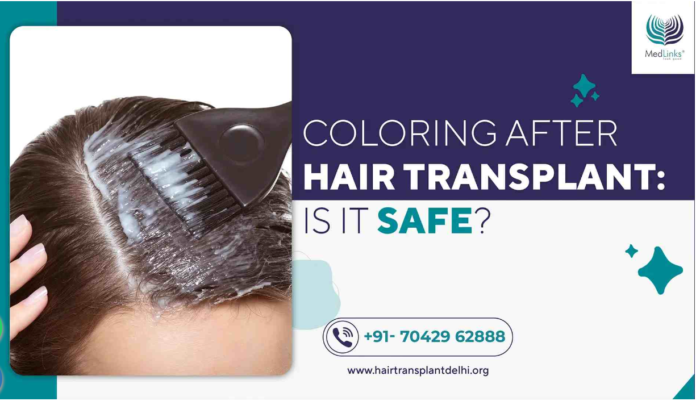If you’ve recently undergone a hair transplant or are considering one, you might be wondering about the safety and feasibility of coloring your hair post-procedure. At Medlinks, we understand the desire to achieve your ideal look, and we’re here to guide you through the process to ensure your hair remains healthy and vibrant. This article will delve into the intricacies of coloring after hair transplant and provide you with comprehensive information to make an informed decision.
Understanding Hair Transplants
Before exploring the safety of coloring after a hair transplant, it’s essential to understand what a hair transplant entails. A hair transplant involves moving hair follicles from one part of your body, usually the back or sides of your scalp, to areas experiencing hair thinning or baldness. This procedure can significantly enhance your appearance and boost your confidence, but it also requires careful post-operative care to ensure optimal results.
The Recovery Phase
The first few weeks following a hair transplant are critical for healing and establishing the newly transplanted hair. During this period, the transplanted follicles are vulnerable and need special care to take root and grow effectively. Medlinks emphasizes the importance of following all post-operative instructions provided by your surgeon to ensure a smooth recovery process.
When Can You Start Coloring Your Hair?
One of the most common questions we receive at Medlinks is about the appropriate time to start coloring hair after a transplant. Generally, it is advisable to wait at least 4-6 weeks before considering any hair coloring treatments. This waiting period allows the scalp to heal and the transplanted hair follicles to stabilize.
Why Wait?
-
Healing Process: The scalp needs time to heal from the micro-incisions made during the transplant. Applying hair dye too soon can irritate the scalp and interfere with the healing process.
-
Folicular Integrity: Newly transplanted hair follicles are delicate and need time to secure themselves in the new location. Hair dye chemicals can potentially damage these fragile follicles, leading to suboptimal results.
-
Color Uniformity: Waiting for the transplanted hair to grow out ensures that any color treatment will be applied uniformly, resulting in a more natural and even appearance.
Choosing the Right Hair Dye
When the time comes to color your hair, selecting the right type of dye is crucial. Medlinks recommends using gentle, ammonia-free hair dyes that are less likely to cause irritation. Here are some options to consider:
-
Semi-Permanent Dyes: These dyes are less harsh and gradually fade over time, making them a safer option for newly transplanted hair.
-
Natural Dyes: Products containing natural ingredients like henna can be gentler on the scalp and hair.
-
Professional Salons: Visiting a professional salon ensures that the dye is applied correctly and that your hair and scalp are cared for by experts.
Precautions to Take
To ensure the safety of coloring after a hair transplant, consider the following precautions:
-
Patch Test: Before applying any dye, conduct a patch test to check for allergic reactions or sensitivity.
-
Hydration: Keep your scalp and hair well-hydrated to minimize the risk of irritation from the dye.
-
Avoid Harsh Chemicals: Steer clear of hair products containing harsh chemicals that could damage your hair and scalp.
-
Consult Your Surgeon: Always consult with your hair transplant surgeon before applying any hair dye. They can provide personalized advice based on your specific situation.
Post-Coloring Care
After coloring your hair, proper care is essential to maintain the health of your hair and scalp. Medlinks suggests the following post-coloring tips:
-
Use Mild Shampoos: Opt for shampoos and conditioners designed for colored hair, free of sulfates and parabens.
-
Avoid Heat Styling: Minimize the use of heat styling tools to prevent further damage to your hair.
-
Regular Trims: Regular trims help to maintain the health and appearance of your colored hair.
-
Deep Conditioning: Incorporate deep conditioning treatments into your routine to keep your hair moisturized and vibrant.
Medlinks: Your Partner in Hair Care
At Medlinks, we are committed to providing comprehensive care and guidance throughout your hair restoration journey. Our team of experts is dedicated to ensuring the best possible outcomes for our patients, from the initial consultation to post-operative care and beyond.
Conclusion
Coloring after hair transplant is generally safe if done correctly and at the appropriate time. By following the guidelines provided by your surgeon and taking necessary precautions, you can achieve the hair color you desire without compromising the health of your newly transplanted hair. At Medlinks, we are here to support you every step of the way, ensuring you achieve not only the hair density you desire but also the color and style that makes you feel confident and beautiful.
For more personalized advice and to schedule a consultation, contact Medlinks today. Let us help you navigate the journey to vibrant, healthy hair with confidence and ease.


